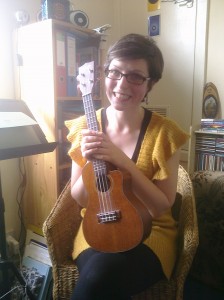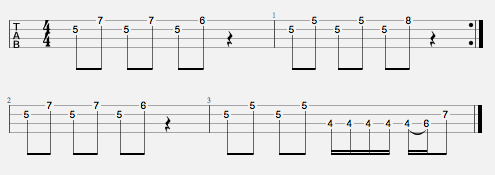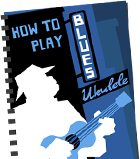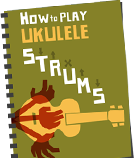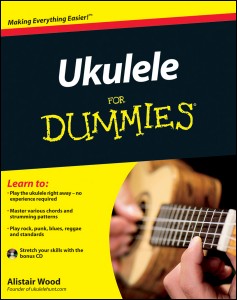 Back when I first started the blog I would bemoan the lack of beginner ukulele books. The situation has improved since then. But I still felt like there wasn’t a definitive book that covered all the important aspects of ukulele playing – particularly the way the ukulele is being played currently.
Back when I first started the blog I would bemoan the lack of beginner ukulele books. The situation has improved since then. But I still felt like there wasn’t a definitive book that covered all the important aspects of ukulele playing – particularly the way the ukulele is being played currently.
Last year the people who do the …for Dummies books made me put my balls where my blog is and actually write one myself. So for the last 9 months I’ve been working really hard to make this the best beginner’s ukulele book there is out there and now it’s available for pre-order it’s out now. You can find it cheapest (that I’ve seen) on Amazon:
Amazon US
Amazon Canada
Amazon UK
Amazon France
Amazon Germany
And in countries that don’t have Amazon:
The Niles in Australia
Fishpond in New Zealand
A quick guide to what you can expect from it.
UPDATE: Since being released, the book has had a great reaction. You can read a selection of reviews here.
How It’s Going to Make You Awesome
Back in the olden days, people learned to play a musical instrument in a pretty one-track fashion. They’d buy a book and work through it. Or they’d get a teacher and follow their syllabus. But no one learns like that any more. Everyone who learns the ukulele now plays stuff from websites and learns tunes for clubs. So the usual ukulele book that follows the old way doesn’t really work any more.
Ukulele for Dummies is more of a reference book. So – while you can certainly follow through the book in a straight line and learn to play – it works best as a book you can keep nearby and pick up when there’s a particular technique you hear about or you’re trying to play something and it doesn’t quite sound right.
For example:
A website: “Play this bit with hammer-ons.”
You: “What the flipperty-heck does that mean?”
Your Brain: “Look in Ukulele for Dummies. That will tell you.”
*A short read later.*
You: “Thanks, brain. I now know how to play hammer-ons and am thusly much more attractive to the opposite sex.”
If you’ve ever read a Dummies book before, you’ll be familiar with this idea. All the books follow that ‘modular’ pattern where you can read little sections in isolation. Same here. You can read each little bit in on its own and it’ll still make sense.
What You Get
It’s a hefty book: 360 pages all told. So it covers a lot of ground. There’s a list of contents below. Each new bit of technique will have a demonstration of it in a musical context (a lot of the time that’ll be a song or a tune). The book is written for soprano/concert/tenor. It’s not suitable for baritone ukulele.
The book comes with a 98 track CD containing all the musical examples I could cram on it.
If you’ve bought the digital version of the book you can find details of how to download the audio and video here.
Dummies Style
The book is written in the Dummies style rather than mine. The tone is still conversational and laid back. But they’re very keen to keep a consistent style between the books. So if you read something in the book that doesn’t sound like me, that’ll be because it probably wasn’t me.
The big difference is it’s safe for family use. You won’t find any of the swearing, body-part references, ironic uses of the phrase ‘off of’ and calls for an anarcho-capitalist revolution that plague this blog. And it’s also packed with gerunds if that’s your bag.
Contents
The book is put together in a way that lets you zip around and pick out the bits that interest you.
You can download an extract, the contents and the index on the Wiley site.
Part 1: Ukulele Basics
The non-playing section. Covering the fundamentals that are worth getting down before you start.
Chapter 1: Exploring the Ukulele
– Advantages of the ukulele.
– Different sizes.
– Getting to know the ukulele.
– What you can play on the ukulele.
Chapter 2: Tuning Up to Sound Great
– Basic musical terms.
– Tuning up.
– Deciding which tuning to use.
– Methods of tuning.
Chapter 3: Discovering How to Handle Your Ukulele
– Holding the ukulele.
– Preparing to strum.
– Fretting without worrying.
Part 2: Chords and Strumming
Chapter 4: Playing Your First Ukulele Chords and Songs
– Chord diagrams.
– Fretting your first chords.
– A simple strum.
Chords: Li’l Liza Jane, I’ll Fly Away, Wayfaring Stranger.
Chapter 5: Drumming Up More Strumming Patterns
– Strumming Patterns.
– Strumming in genres.
– Playing when you don’t know the pattern.
Chords: What Did the Deep Sea Say?, Shady Grove, Take Me Out to the Ballgame, House of the Rising Sun, 12 Bar Blues, Banana Boat Song (Day-O).
Chapter 6: Meeting the Chords and Their Families
– The C chord family.
– The three chord trick.
– Barre chords.
– Increasing your chord arsenal.
Chords: When the Saints Go Marching In, Man of Constant Sorrow, Irish Rover.
Part 3: Picking and Single Note Playing
Chapter 7: Getting to Grips with Tabs and Notation
– How to read tablature.
– Reading rhythms.
– Getting it all together.
Melody tabs: London Bridge Is Falling Down, I’ll Fly Away, Take Me Out to the Ballgame.
Chapter 8: Fingerpicking Patterns
– Fingerpicking technique.
– Fingerpicking patterns.
Chapter 9: Combining Chords and Melodies When Playing Solo
– Thumb strumming.
– Strumming between the melody.
– Strumming through.
– Fingerpicking.
Melody and chord tabs: London Bridge is Falling Down, Amazing Grace, In the Pines (Where Did You Sleep Last Night?), When the Saints Go Marching In, I’ll Flay Away, Freight Train.
Amazing Grace
I’ll Fly Away
When the Saints Go Marching In
Chapter 10: Picking Up Some Soloing Techniques
– Soloing techniques: hammer-ons, pull-offs, slides, bends, vibrato.
– Picking notes for solos.
– Inventing your own solos.
Part 4: Genres and Styles
This section takes the stuff from parts 2 and 3, applies it to different genres and adds new techniques.
Chapter 11: Rock and Punk
– Rock and punk chord progressions.
– Rock riffing.
– Rock soloing.
Chapter 12: Blues
– 12 bar blues variations.
– The blues shuffle.
– Blues turnaround variations.
– The blues scale in solos.
Chords: Careless Love, St James Infirmary.
Melody: Memphis Blues.
Memphis Blues
Chapter 13: Hawaiian
– Hawaiian strumming: chnking, triplet strum.
– Hawaiian turnarounds.
– Playing Hawaiian tunes.
Chords: Aloha ‘Oe,
Melody tab: Papalina Lahilahi.
Melody and chords tab: Alekoki.
Alekoki
Chapter 14: Jazz
– Jazzy chord turnarounds.
– Jazzing up chords.
– Split stroke.
– Faking a jazz solo.
Chords: Darktown Strutters’ Ball.
Tab: 12th Street Rag.
Chapter 15: Reggae and Jawaiian
– Touch strum
– Thumb ‘n strum.
– Marley-style strumming.
– Skanking.
Chords: Linstead Market.
Chapter 16: Classical
– Strumming and picking classical tunes.
– Campanella playing.
Tab: Ode to Joy, Brahms’s Lullaby, Greensleeves, Romanza, Carulli’s Andante.
Part 5: Buying and Looking After Your Ukulele
For people who don’t have a ukulele yet, this would be a good section to read first.
Chapter 17: Buying a Ukulele
– Knowing what to look for.
– Choosing where to buy.
– Buying more ukuleles.
– Going electric.
Chapter 18: Essentials and Accessories
– Finding the best strings.
– Optional accessories.
– Websites, apps and programs.
Chapter 19: Re-Stringing, Maintaining and Adjusting Your Ukulele
– When and how to restring.
– Keeping your ukulele in tiptop condition.
– Identifying and fixing problems.
Part 6: The Part of Tens
All Dummies books have a section at the end listing ten sets of things. But I can’t count.
Chapter 20: Ten Ukulele Players You Should Know
Quick profiles of:
– Ernest Ka’ai.
– May Singhi Breen.
– Roy Smeck.
– George Formby.
– The Ukulele Orchestra of Great Britain.
– Israel Kamakawiwo’ole.
– Jake Shimabukuro.
– James Hill.
– Zach Condon.
– Julia Nunes.
– I also did an ‘If you like… check out…’ who are, respectively, John King, Nellie McKay, Bob Brozman, Garfunkel and Oates, Wellington International Ukulele Orchestra, Paula Fuga, Kalei Gamaio, Paul Luongo, tUnE-yArDs and Sophie Madeleine.
Fight about those as much as you like in the comments.
Chapter 21: Ten Ways to Get Involved in the Ukulele Scene
– Joining a ukulele club.
– Visiting a ukulele festival.
– Making a video.
– Playing live.
– Going online.
– Spreading the uke news.
– Entering a contest.
– Teaching someone.
– Writing your own songs.
– Seeing a show.
Chapter 22: Ten Tips for Improving
– Playing very slowly.
– Refusing to rush things.
– Recording yourself.
– Playing with and for others.
– Practicing in sections.
– Knowing when to stop practicing.
– Steal from everyone.
– Varying your inversions and verying your invarsions.
– Opening your ears.
– Enjoying yourself.
– Busting a rut.
Appendices
Appendix A: Chord Charts
Appendix B: Reading Music
Appendix C: Using the CD
How You Can Order It
It’s due out in August and you can pre-order it in these places (and some others):
US
Amazon US
Borders
Barnes and Noble
Australia
Fishpond (Australia)
Got A Question?
Ask away in the comments.
Question Updates
Some pertinent questions from the comments:
Will there be an ebook version?
Yes, there’s going to be an enhanced, downloadable version. You can read about it on iTunes.
Will it be available in (insert language here)?
There have been discussion about translated versions. If you want to sway the decision go on the Wiley website, pick your location, contact them expressing your interest.


